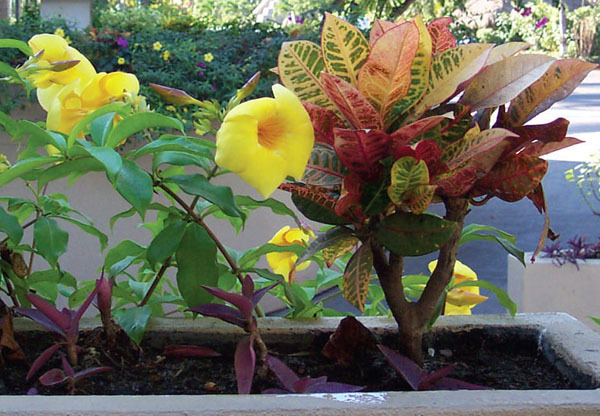Three beautiful options for your tropical garden in Mexico are the allamanda, tulipan and zamia.
Allamanda ( Allamanda cathartica)

Family: Apocynaceae
Alternate Names: Golden Trumpet, Bush Allamanda
Use: The allamanda is grown as an informal fence in tropical climates, and as a houseplant elsewhere. It is excellent for use in planter boxes, especially when used with other brightly colored flowers for contrast.
Flowers: This plant produces clusters of showy, trumpet-shaped flowers, to 4 inches in diameter. A.blanchetii is purple, while the more common A. cathartica is jonquil-yellow. The Stansill’s Double variety has double yellow flowers. In cultivation, it generally does not produce fruit.
Cultivation: The allamanda is a vining or loosely shaped shrub in habit. It requires full sun and warm temperatures for best flower production. Water it lightly in the cooler months, and provide more water during hotter periods. Fertilizer, especially liquid manure, produces vibrant flower clusters. Prune heavily to improve its shape.
Propagation: This plant is rooted from 3-inch tip cuttings taken in the spring. The reddish-purple type is frequently grafted onto rooted cuttings of A. cathartica.
Tulipan ( Spathododea campanulata)
Family: Bignoniaceae
Alternate names: African Tulip Tree, Spathodea nilotica, Sorcerer’s Wand, Flame of the Forest, Tulip Tree, Fountain Tree
Use: The tulipan is planted as a specimen tree, for shade, or along city streets or in parks. It is used throughout the warmer climates of the world and grows to 50 feet or more in the wild.
Flowers: The beautiful, bright orange-scarlet flowers are 4 inches diameter and are lined with yellow. They appear in large racemes at the ends of branches, and open a few at a time, with the process lasting several months and thus providing a lengthy display. “Kona Gold” has yellow flowers.
Cultivation: The tulipan tolerates many soil types, but does best in rich soil. It is seen in moist habitats below 3000 feet elevation and will grow to as much as 80 feet tall in sheltered ravines. It prefers full sun and regular watering for best flowering, but will tolerate drought. Prune heavily after any freeze.
Propagation: The tree is propogated from seeds, which are contained in woody capsules. They are winged, and the wind carries them afar, naturalizing the trees. It can also can be propagated by tip cuttings and by root cuttings, or suckers.
Note: The trees may become hollow with age, posing a hazard of breaking and falling branches.
Zamia maritima (farfurecea)
Family: Cycad
Alternate Name: Cardboard Palm
Use: The zamia is a landscape specimen, an attractive plant for large containers in public spaces, balconies and patios. It is also grown as bonsai.
Flowers: Inconspicuous/none.
Cultivation: This plant tolerates the dry season and various soil conditions. It is hardy in full sun to part shade. It is salt tolerant, and grows at sea level and low altitudes. It can be established in rocky or sandy soil and grows to 4 o 5 feet, with many branches from an underground or emergent trunk. The zamia may reach a spread of 6 feet in good growing conditions. It is widely used for its hardiness and attractiveness.
Propagation: Both males and females produce cones. Sow seeds from cones, cleaned and dried, promptly.
Note: All parts are poisonous and the seeds may be harmful to pets. This “living fossil” plant has survived since the time of the dinosaurs. The leaves are slightly fuzzy, and have a cardboard feel. In shade, leaves will be further apart than in full sun.












